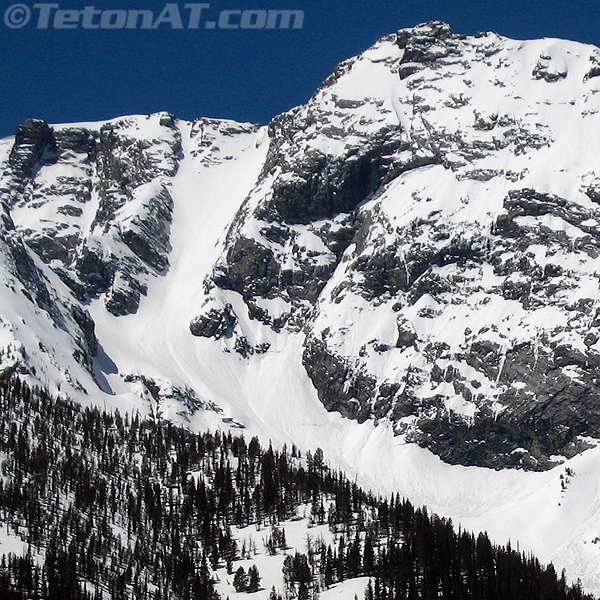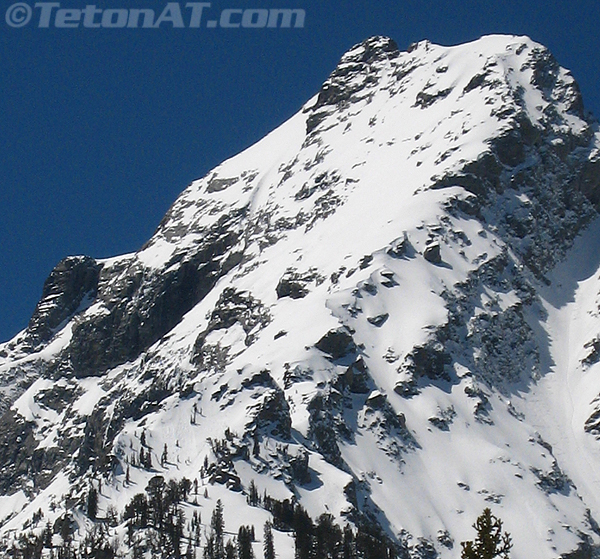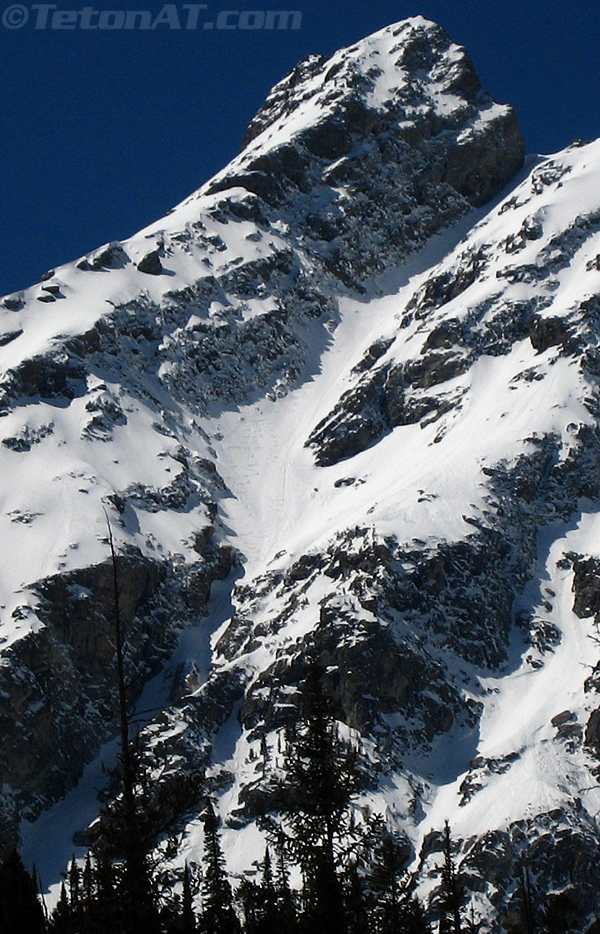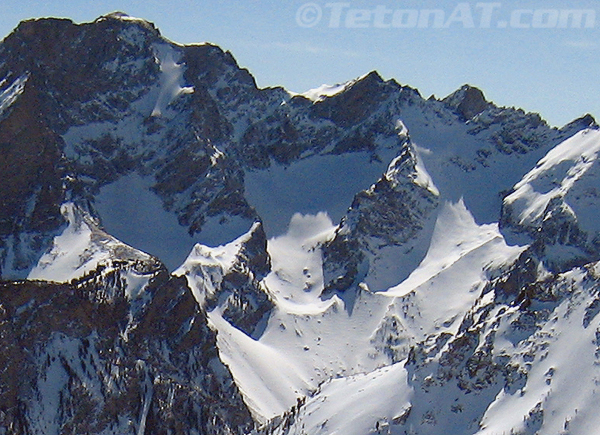
Upper half of the Skillet Glacier.
Skillet Glacier– The most classic and sought after descent on Mount Moran is by far the Skillet Glacier. In the past, this line would rarely see descents during the mid-winter months, but more recently, the six mile approach across Jackson Lake has been tackled during the wee hours of the morning and now is often done “in a day” from Colter Bay. Few other runs in Grand Teton National Park offer such a long, direct and continuous shot to the valley floor without some sort of traverse, uphill climb or low angle skiing. Though the steep pitch of the upper handle (near 50 degrees) mellows out after a couple hundred vertical feet, the Skillet continues to offer relatively steep skiing for nearly another 2,000′ until it really begins to kick back to more moderate slopes about halfway down the pan section. Fun ridges and gullies are then followed down to the lower moraines. Approach from Colter Bay in mid winter when the lake is frozen, String Lake trailhead when the park road is plowed and/or during transition time on the lake, or Spaulding Bay once most of the snow in the valley has melted and Jackson Lake is ice free. Best time of year to hit this line depends on your fitness and avalanche hazard.

Upper Northeast Ridge of Mount Moran.
Northeast Ridge– Though an impressive, proud and aesthetic line, the Northeast Ridge of Mount Moran has seen few descents over the years and as of today, I can probably count the number of descent on tow (if not one) hand. Its upper pitches are over 50 degrees above huge cliffs that fall down to the Skillet Glacier on its north side. Once off the face and on to the ridge proper, descentionists may choose a variety of routes to gain the lower mountain whether it be to the south towards the lower Skillet (the most manky), continuing on the ridge on the north side of the gendarme (the trickiest) or dropping to the north and descending to the cirque in the vicinity of the Sickle Couloir…which I think has the most appeal. A deep and stable snowpack with good skiing conditions is needed to make the upper reaches of the ridge enjoyable and not too death defying. Best time of year to hit this line is early spring, once the snow stabilizes and the upper face is filled in.

Ski tracks in the Sickle Couloir.
Sickle Couloir– Probably the third most popular ski-line on Mount Moran (meaning it might get 3-4 descents on a busy year), this couloir looks extremely impressive when viewed from the northeast. Its combination of remoteness, terrain and technicality make it worth of any aspiring Teton ski mountaineer’s “hit-list”. After a few steep turns from the col at the top, the wide upper couloir rates somewhere in the 45 degrees mark for a good 2000′ before it pinches down entering the crux of the route. A deep snowpack is often needed to make the lower exit couloir to the skiable. During its first descent in June of 1992, Jeff Rhoads and Cory Flandrow opted for a higher exit (most likely due to nasty runnelled conditions just above the exit couloir) and traversed on steep ledges to access another couloir to the east. Nailing the approach through the thick trees at the lower elevations in the dark is imperative, unless one is setting up a camp in the cirque below the couloir. Best time of year to hit this line is in the early spring when snow conditions stabilize and the exit couloir is filled in.

Triple Glaciers on the north side of Mount Moran.
Triple Glaciers– Skiers will have to pay the price, meaning a long approach and thick bushwhacking in Moran Canyon, to access the very north facing Triple Glaciers region of Mount Moran. Three separate glaciers occupy three separate cirques on the dark side of the mountan. The eastern most glacier extends up to a steep couloir on the skiers right that connects to the north ridge and shares a col with the Sickle Couloir. The middle glacier ends at a tall and steep cliff, stopping any further travel. While none offer skiing from the summit of Moran, the western most glacier could offer a summit-like descent feel when skied from a ridgeline to the west. These glaciers rarely see ski tracks…for good reason. Best time of year to hit these lines is when you have the drive, determination and stubbornness to “get ‘er done”!
(ref: Teton Skiing: A History and Guide to the Teton Range)

Since no one else is giving love for the guide book, I shall again. Thanks Steve!
Thanks Dude!
I’ve been getting lots of comments (and questions) via email…so I know people appreciate it.
Steve,
Thanks much for the info. A crew of us “colorado boys” came up and took care of a couple decents around there over the weekend, including Moran. What a sweet line!
Jordan